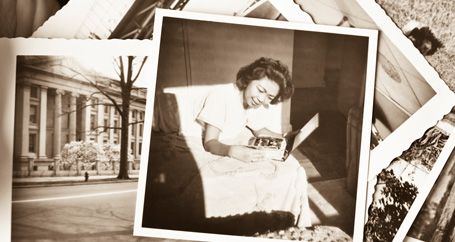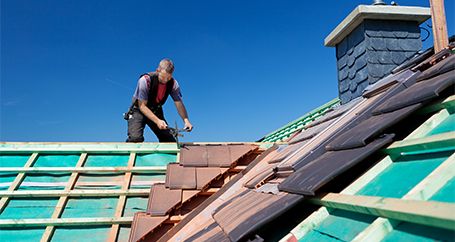"[Packing to evacuate] is like robbing your own house."
— Wes Michy
When the fire crew knocked on Wes Michy's door in Grass Valley, California, and told him he had 20 to 30 minutes to evacuate, Michy was already two steps ahead.
After living through several natural disasters — including weathering a tornado inside a bank vault — his go-bag of emergency essentials was already packed.
It gave Michy a few extra minutes before fleeing with his wife, so he did the only thing he could think of to protect his home: He quickly hosed down the yard and roof to dampen dry debris, like the pine needles that collected in the gutters.
The fire came within two blocks of his home, but no stray embers sparked a flame on his property — a fact he attributes, at least in part, to the last-minute watering.
Michy’s experience is just one example of how dire circumstances can inspire the most resourceful thinking during and after a natural disaster. Here, first responders and other disaster survivors share the real-life disaster "hacks" that helped save their property, their lives and their sanity in the aftermath.
GRAB

Inside Michy’s go-bag, you’ll find typical emergency gear: spare clothes, a first aid kit, food and water. You’ll also find a sheet of paper listing valuables and where they’re located in his home. The list helps him remember what to grab if there’s time (heirloom diamonds, baby photos) or, worst-case scenario, can be helpful if these items are destroyed. Packing to evacuate is "like robbing your own house," he says. You take what you can as quickly as possible and leave.
UNPLUG

Sasha Jones’s family had been living with off-and-on electricity for days after Hurricane Wilma hit Naples, Florida, in 2005. Then, a power surge through the cable modem line fried her computer and other plugged-in electronics. “Now, I unplug everything when I see a major storm coming,” says Jones, a retired contractor and third-generation Floridian.
For homeowners who shelter in place and have generators powering appliances, she also recommends turning a home’s main breaker off while the power is out. “This can help prevent surges when the power comes back on.”

Airborne embers from a wind-fueled firestorm or fire tornado can scatter more than a mile.
—California Department of Forestry and Wildfire Protection
CLOSE

Click to see UL Firefighter Safety Research demonstrating the dramatic, life-saving difference a door can make.
Hurricane winds tunneled insulation and destroyed almost everything inside Kelli Hollis's daughter's home in Panama City, Florida. Surveying damage afterward, Hollis was struck by an incredible sight. "Only one room was spared: the extra bedroom, where the door was shut." Her grandson’s room, directly next to the spare bedroom, was destroyed beyond recognition.
High winds from storms put an incredible amount of pressure on a home. According to testing by the Insurance Institute for Business & Home Safety, closing all interior and exterior doors and windows compartmentalizes pressure and helps to keep pressure from building inside and pushing up against the roof, so the roof has a better chance of not blowing apart.
Closed doors can also save lives and help to reduce damage during a fire, says Steve Kerber, director of the UL Firefighter Safety Research Institute. A startling from UL FSRI statistic explains why: Synthetic materials used in newer construction and furniture contribute to homes burning about five times faster today. On average, a person has three minutes to escape a burning home alive, compared with 17 minutes 40 years ago.
In testing conducted by firefighters at UL FSRI, rooms with open doors were quickly engulfed in smoke and flames, and the time for survivability was reduced to two or three minutes; survival time increased by five minutes in rooms with doors closed.
COOL

Experience has taught meteorologist Tim Marshall the value of simple creature comforts in a disaster. Marshall has been chasing storms since 1978, and he’s a structural and forensic engineer whose job involves on-the-ground damage assessments after natural disasters like Hurricane Katrina in 2005. When he’s forced to ride out a storm at his Texas home, Marshall cranks down the air conditioning as low as it goes. “When the power goes out, I have the coolest room around for hours."
TURN

Seismologist Tom Heaton was rattled awake at 4:30 a.m. in his Pasadena, California, home by the Northridge earthquake in 1994. Before dashing into work to start assessing damage around the city, he knew he had one critical job to do at home: check for gas leaks caused by broken or loosened pipes. “Fire inevitably follows earthquakes,” says Heaton. (Natural gas leaks cause 20 to 50 percent of earthquake-related fires in California, according to the IIBHS.) Fortunately, there was no leak (which he’d know by the telltale rotten-egg scent or hissing sound of gas escaping).
Homeowners in earthquake-prone regions who don’t have a quake-triggered automatic shutoff should know how to turn off a gas valve main, he says. And, to avoid a last-minute scramble to find the right tool, zip-tie a wrench capable of turning the valve to the meter. Once turned off, gas should only be turned back on by a professional who can assess the pipes for damage.
LACE UP

Tim MacWelch wasn’t in New York City during the 9/11 terrorist attacks, but he’s still haunted by the images he saw of women’s high heels littering the streets. “Women had to cast them off so they could run,” says MacWelch, founder of a survival training bootcamp in Virginia. It’s the reason sturdy, closed-toe shoes or boots are at the top of his survival gear list. He recommends keeping a spare pair in your car or at the office, based on the most common disaster threats in your region. Think: getting stranded roadside in a blizzard, walking through debris and glass after a tornado or earthquake, or wading through filthy floodwaters.
VIDEO

Sara Zabukovec has a ritual at the start of every hurricane season. The Hobe Sound, Florida, resident spends a few minutes taking floor-to-ceiling photos and video of her entire home. "I open every drawer and closet. I even open the refrigerator and freezer to take photos.”
Inventorying a damaged home can magnify the trauma of loss and requires valuable time that could delay filing a claim and starting the recovery process, says Marshall, the meteorologist, who has seen exactly how tornadoes, hurricanes and floods turn the contents of a home into an unrecognizable heap. He stores up-to-date pictures of his home and belongings on a hard drive and in the cloud. “Every room, all possessions, all jewelry — not only on my computer, but a back-up hard drive in a storage safe.”
SHOP

Ana Gotter has sheltered in place through a handful of serious storms and hurricanes near Orlando, Florida, and has witnessed locals in “hurrication” mode stocking up on things like boxed wine and chips. After so many false alarms, residents of disaster-prone areas can lose a sense of urgency when storms are forecast. But living on party foods is no picnic. Her pre-storm advice: Be sure your emergency supplies contain foods you can eat every day for a week straight. Gotter buys shelf-stable nutritious items: potatoes for the grill, cans of tuna, avocados, carrots, bananas, peanut butter.
BREW

D.J. Sprenger gets dropped into the worst disaster zones as part of Team Rubicon, a nonprofit that brings volunteers to calamities around the world. Depending on the disaster, he packs his gear — safety helmet, life jacket, full chest waders, steel-toed boots — and a collapsible French press and ground coffee. “In my experience, having coffee is the best thing in the world,” says Sprenger. In a pinch, you can make cowboy coffee: Boil water, add coffee grounds and return to a low boil; drink once the grounds sink to the bottom.
"When a disaster turns your world upside down, “the one thing you need is your mind."
—Jeremiah Johnston
HEAT

Matt Cobb lived without electricity for 110 days after Hurricane Irma hit St. Thomas in the Virgin Islands. The one item he couldn’t live without: a full tank of propane (plus one backup tank) for grilling, heating water for coffee, warming up cans of soup and warming water for a sponge bath. When fresh meat was unavailable for three weeks, he and his girlfriend relied on canned meats and let their creativity dictate what they would eat with it. His go-to meal: seared canned ham with onions.
RESERVE

In barely 48 hours, Hurricane Michael went from a Category 2 to a near-Category 5 storm off Florida in 2018. Nearby hotels were fully booked, and Panama City Beach resident Jeff Benes was somewhat lucky because he only had to drive 190 miles to find the last room at a motel just north of Mobile, Ala. When cellular service went down, he relied on his sister, who lives in Ohio, to find another hotel room for him in Montgomery, Ala. — another three-hour, 170-mile drive away. Now, as soon as a serious storm hits the news, he books a hotel with a flexible cancellation policy.
Changing the date on a nonrefundable reservation may allow you to cancel it later, depending on the hotel’s policy. Hotels aren't required to refund money on non-refundable reservations, but laws prevent hotels from charging exorbitant rates when a state of emergency has been declared. Florida, Alabama and South Carolina have anti-price-gouging laws that name lodging as a protected commodity for consumers; other states have laws against raising the price of supplies after a state of emergency is declared, which may include hotels. (For details about your state law’s, contact the state consumer protection agency.)
WATER

Linda Dorrance Cave lived without running water for 2 ½ weeks after Hurricane Michael by taking the “fill your bathtub and sinks with water” advice one step further: She lined indoor trash cans with clean bags and filled them with water, too. "My neighbor and I took baths from that can,” she says, noting the water can also be used to manually flush toilets.
REPURPOSE

When Keith Dorsey’s refrigerator tapped out before Hurricane Irma made landfall in 2017, he tossed its contents into his washing machine with a few bags of ice. Left closed and covered with a blanket for insulation, melting ice drains away easily (which is why this won’t work in a refrigerator), and the washing machine may keep food cold two to four days, Dorsey says.
GLOW

When floodwaters rise suddenly, heading upstairs inside a home may be a natural instinct — but it can make escaping difficult and dangerous, says Louisiana Cajun Navy founder Clyde Cain, who has rescued hundreds of flood victims from their homes. “Get on top of the roof, take a tent, nail it down and hunker down. Don’t go to the attic.” Once safe on a roof, evacuees need four things to survive until rescue, according to Cain: a whistle, a life jacket, a glow stick and a water bottle with a built-in filter. “If I can see a glow stick or hear a whistle, I can get you.”
"If I can see a glow stick or hear a whistle, I can get you."
— Cajun Navy founder Clyde Cain
COVER

When he’s navigating floodwaters in a search and rescue operation, Cain wears knee-high rubber boots to avoid contaminated water, and he recommends flood victims protect skin against direct exposure to water. "Floating on an air mattress is better than wading through that water. I’ve seen people lose their legs, their arms, their life” from injuries exposed to contaminated water, says Cain.
MacWelch recommends wrapping exposed limbs in garbage bags before putting on shoes — which are a must to protect feet from barbed wire, boards and nails. “In muddy water, you can’t see where you’re stepping,” he warns.
BREATHE

Panic and fear can be a natural by-product of experiencing a disaster. The most simple, basic activity — focused breathing — can help, says MacWelch. “A little bit of fear is useful and keeps us from doing stupid things,” he says. “When fear runs unchecked, that turns into panic.”
Tactical breathing is used by the military to help remain calm when adrenaline is running high. Breathe in for four counts, hold the breath for four counts, and then breathe out for four counts. Studies show that it can lower blood pressure and increase the success of medical procedures in a stressful situation.
Survival hacks can make the day-to-day misery of living through natural disasters more bearable, but the trauma leaves indelible marks, says Marshall. Even after years of assessing disaster damage, he never fully shakes the weight of what he has witnessed. “It’s the dark and deep and raw emotion,” he says. “I cannot get used to it.”
It's an emotional toll Jeremiah Johnston knows well. He lost two homes to hurricanes in Texas. “Once your house gets destroyed, you will probably go through some grief or trauma," says Johnston. “It does not hurt to go to a therapist.” It’s normal to feel overwhelmed — but it’s also the time you need to be most focused, he says. When your world is turned upside down by a disaster, “the one thing you need is your mind.”

See the Federal Emergency Management Agency’s Disaster Application Checklist for a list of documents to keep in digital or hard-copy format in an emergency go-bag.
Written by
The information contained in this page is provided for general informational purposes only. The information is provided by Farmers® and while we endeavor to keep the information up to date and correct, we make no representations or warranties of any kind, express or implied, about the completeness, accuracy, reliability, suitability or availability with respect to this article or the information, products, services or related graphics, if any, contained in this article for any purpose. The information is not meant as professional or expert advice, and any reliance you place on such information is therefore strictly at your own risk.
Related articles




